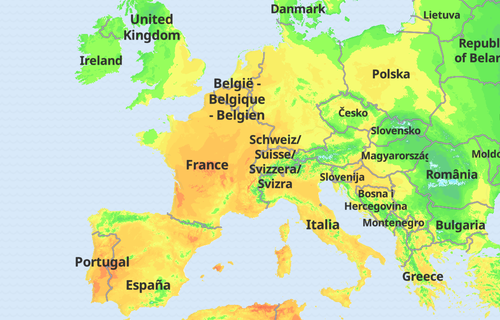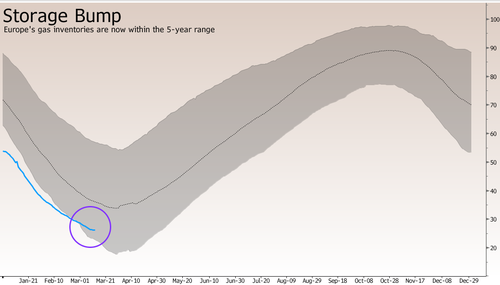European Gas Injections Begin As Warmer Temperatures Trend
Temperatures in Europe are turning higher as peak winter is over and spring nears. Heating demand declines as mild weather spreads through Europe. This is great news for the continent’s ongoing energy crisis.
Peak winter appears to have been recorded in the mid/late January timeframe when average temperatures in Europe were 30 degrees Fahrenheit. At the time, Europe was sliding into an energy crisis with declining supplies from Russia and stockpiles at extremely low levels. Then the Russian invasion in late February sent prices skyrocketing.
Bloomberg cites data from Gas Infrastructure Europe, showing energy companies in Germany, France, and Poland are taking in more natural gas than withdrawing from stockpiles which could suggest restocking begins.
This could be happening because heating demand decreases as temperatures are expected to be in the mid-60s in Paris on Wednesday. Declining demand has brought some relief to energy markets, still dealing with potential supply disruptions as the Russian invasion of Ukraine wages on.
“Mild weather in Germany is improving the outlook,” said Ron Smith, a senior analyst at BCS Global Markets.
“Gas markets seemingly are slowly reducing the geopolitical risk premium in European prices as it becomes increasingly apparent that Russian flows are not likely to get interrupted in the near term,” said Smith.
Despite the turmoil in Ukraine, gas continues to flow through Ukraine. As spring nears, less demand for heat has pushed Europe’s gas inventories within a five-year range, though on the lower end.
However, concerning data from the Yamal-Europe pipeline, connecting Russian gas fields with Poland and Germany through Belarus has reversed gas flows to Europe. This could mean possible future disruptions to energy supplies. As a result, Dutch gas prices jumped today as much as 12% to 123.50 euros per megawatt-hour.
The question is whether Europe will begin an injection season as warmer temperatures reduce heating demand. There are obvious challenges such as reversal in pipeline flows that could crimp supplies.
Injection season typically begins at the end of March and or early April. Bloomberg said, “the continent now wants to ensure the security of supply, with plans to require existing storage facilities to be filled up to at least 90% of their capacity by Oct. 1 each year. But the task won’t be easy.”
“But the task won’t be easy. A rare premium for summer gas over winter supplies means companies can’t make money by storing the fuel. That may reduce commercial incentives to inject gas,” Bloomberg added.
Europe’s critical restocking period is about to begin. There are many uncertainties about Europe’s depleted gas storage getting refiled ahead of next winter. If Russia does restrict supplies, Europe has made plans to source gas elsewhere.
Tyler Durden
Wed, 03/16/2022 – 06:40
via ZeroHedge News https://ift.tt/O4YMVcy Tyler Durden



